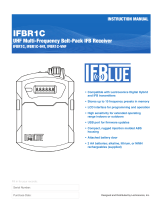
SRc5P and SRc Dual Receivers - SRc5P, SRc, SRC5p-941, SRc-941, SRc5P-961, SRc-961
LECTROSONICS, INC.6
Three Block Tuning Range
The SRc receiver tunes across a range of over 76 MHz.
This tuning range covers three standard Lectrosonics
frequency blocks.
BLOCK BLOCK BLOCK
Tuning ranges are available covering standard blocks as
follows:
Band Blocks Covered Freq. (MHz)
A1 470, 19, 20 470.100 - 537.575
B1 21, 22, 23 537.600 - 614.375
B2 22, 23, 24 563.200 - 639.975
Block 606 23, 24 606.000 - 631.500
C1 24, 25, 26 614.400 - 691.175
Block 941 941 941.525 - 959.825
Block 961 961
961.100 - 1014.900
To simplify backward compatibility with earlier Digital Hy-
brid Wireless® equipment, block numbers are presented
along with frequencies in LCD screens.
RF Front-End with Tracking Filter
A wide tuning range is helpful in nding clear frequen-
cies for operation, however, it also allows a greater range
of interfering frequencies to enter the receiver. The UHF
frequency band, where almost all wireless microphone
systems operate, is heavily populated by high power TV
transmissions. The TV signals are immensely more pow-
erful than a wireless microphone transmitter signal and
will enter the receiver even when they are on signicantly
dierent frequencies than the wireless system. This pow-
erful energy appears as noise to the receiver, and has
the same eect as the noise that occurs with extreme
operating range of the wireless system (noise bursts and
dropouts). To alleviate this interference, front-end lters
are needed in the receiver to suppress RF energy below
and above the operating frequency.
The SRc receiver employs a variable frequency, tracking
lter in the front-end section (the rst circuit stage
following the antenna). As the operating frequency is
changed, the lters re-tune in ne increments to stay
centered over the selected carrier frequency.
In the front-end circuitry, a tuned lter is followed by an
amplier and then another lter to provide the selectivity
needed to suppress interference. This unique lter design
allows a wide tuning range and retains the sensitivity
needed for extended operating range.
IF Ampliers and SAW Filters
The rst IF stage employs two SAW (surface acoustic
wave) lters. The use of two lters signicantly increases
the depth of ltering while preserving sharp skirts, con-
stant group delay, and narrow bandwidth. Though expen-
sive, this special type of lter allows primary ltering as
early as possible, at as high a frequency as possible,
before high gain is applied, to deliver maximum image
rejection. These lters are made of quartz, and they are
very temperature stable.
In receiver 1, the signal is converted to 248.950 MHz in
the rst mixer stage, then passed through two SAW l-
ters. After the SAW lters, the signal is converted to 350
kHz and then the majority of the gain is applied.
In receiver 2, the same conversions take place at dier-
ent frequencies: rst to 243.950 MHz, then to 250 kHz.
Although these IF frequencies are unconventional in a
wide deviation (±75 kHz) system, the design provides
excellent image rejection.
Digital Pulse Counting Detector
Following the IF section, the receiver uses an elegantly
simple, yet highly eective digital pulse counting detector
to demodulate the FM signal to generate the audio, rath-
er than a conventional quadrature detector. This unusual
design eliminates thermal drift, improves AM rejection,
and provides very low audio distortion. The output of the
detector is fed to the microprocessor where a window
detector is employed as part of the squelch system.
DSP-Based Pilot Tone
The Digital Hybrid system design uses a DSP generated
ultrasonic pilot tone to reliably mute the audio when no
RF carrier is present. The pilot tone must be present in
conjunction with a usable RF signal before the audio
output will be enabled. 256 pilot tone frequencies are
used across each 25.6 MHz block within the tuning range
of the system. This alleviates erroneous squelch activity
in multichannel systems where a pilot tone signal can ap-
pear in the wrong receiver via IM (intermodulation).
The pilot tones are repeated with each successive 25.6
MHz increment across the tuning range of units that tune
across a 3-block band. These units can tune in either 25
kHz or 100 kHz steps. The pilot tones increment in 100
kHz steps, so the pilot tone will be the same for all four
adjacent frequencies in each 100 kHz increment. For
example, 550.100, 550.1256, 550.150 and 550.175 MHz
will all have the same pilot tone.
Pilot tones are also provided for legacy equipment and
some models from other manufacturers.





















